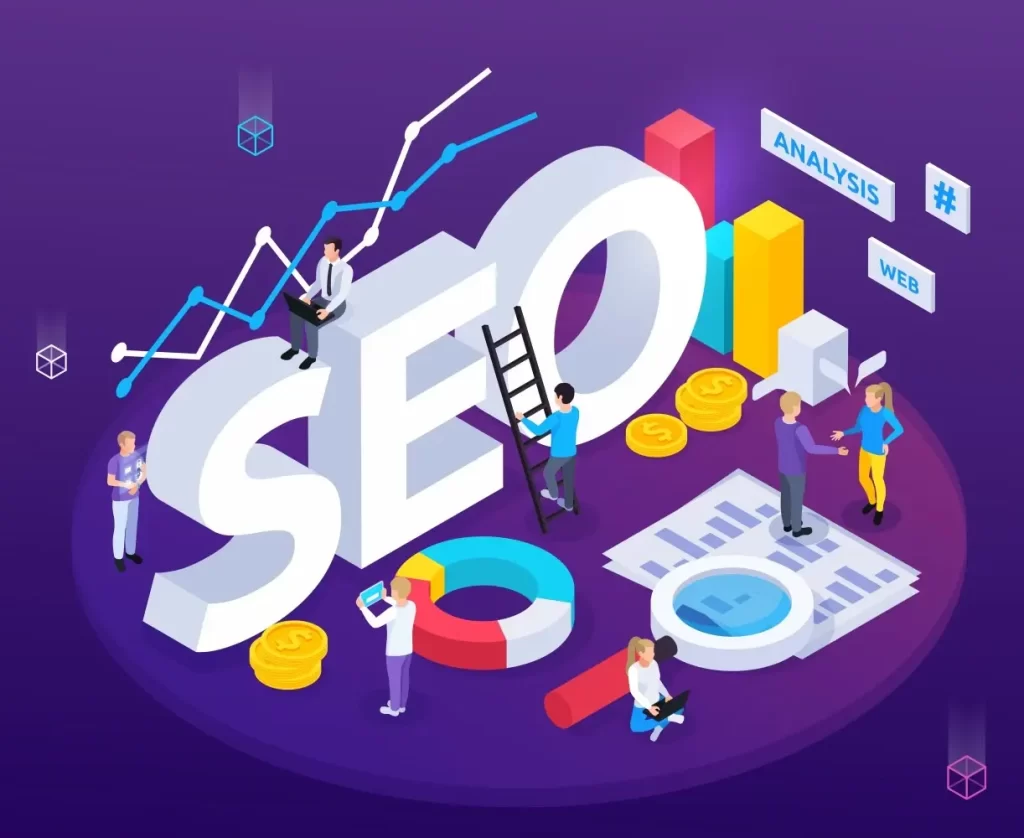SEO, or search engine optimization, is the process in which certain changes and inputs are made for a website so that it ranks higher on the list of the results page when people look up searches with related keywords. This article will be a beginner’s guide to search engine optimization and will go into detail about the types of SEOs and how you can utilize them to draw more engagement to your website too.
What is Search Engine Optimization (SEO)?
What is search engine optimization? You might have come across that word in reference to digital marketing terms.
Informally called SEO, it’s a process that involves changing and inputting certain steps to better rank content on the internet. Essentially, when you type out a question, or a keyword, on the internet, there will be thousands of articles mentioning those specific keywords, so a search engine (like google, bing, etc) has its own algorithm to decide which content will be shown on the first webpage and the last. There are, in fact, differences, but for the sake of continuity, let’s stick with SEO for searches using google.
Importance of SEO:
When people use the internet to browse products or services, chat up people, or look up definitions, they all start from a common point- the search bar.
SEO helps to ensure your article/ webpage content ranks higher on the results page of that search. If your website ranks on the first page, and the higher it is on the first page, the more people would often encounter it when they look up searches matching your keywords.
And as a result, your content would have much better visibility and engagement with the audience of the internet as a whole. From a marketing perspective, SEO strategies have a much better conversion rate, as compared to conventional models of marketing or advertising.
How to become an SEO expert?
There is no one specific formula for becoming a search engine optimization or SEO expert. The search engine sets up the algorithm, and the rules for ranking websites, in order to better your SEO skills, it is necessary to have a foundational understanding of how search engines function. The reason we’re sticking to Google as our search engine is because it constitutes the largest share of the market, and has the most number of people who use the internet, compared to any other search engine.
There are three main ways how a search engine works:
- Crawling: Crawling is in reference to the search engine bots ( also known as spiders or crawlers), responsible for collecting every kind of content available online, and grouping them into one large index, on the basis of their URL (universal resource locator).
- Indexing: Once the URLs are saved into categorical indexes, this is the part where the saved URLs are now retrieved, from the relevant index, and ready to be displayed on the screen.
- Ranking: Once the search results with their relevant keywords and URLs are found, this is the part when the results are displayed from the most common to the least commonly referenced keyword.
With that understanding in mind, let’s look at some basic SEO techniques
Keyword Research & Keyword Targeting Best Practices
By now, it’s understood that by controlling your keywords, you will have a better impact on how a website ends up being ranked.
And by better refining those keywords by understanding your market, and what kind of content, product, or service your customers will be expecting, you can improve your chances at SEO.
Use accurate Titles, Meta descriptions, and heading tags
Once you’ve settled on the right and relevant keywords you plan to use for your website, you should think about how it can be viewed by your general audience and potential customers. This is where your HTML elements come into factor, namely:
- Title tag: Since this is the first thing people will see, it should serve as a clear and concise description of what your webpage is talking about. It should have the target keyword and have a marketable reason for people to click on it.
- Meta description: This is shown right below the title tag, serving to provide an overall impression of your webpage
- Heading tags: These serve as a contents section of the webpage, providing a blueprint of how the content is to be structured.
Manage navigation and URL for convenience
Navigation is the set of links presented allowing a user to move through your web pages. Links present on the webpage, that navigate topic to topic, aren’t indexed by crawlers, but keeping external links (for source citations, and such) accessible directly on the page help.
URL is a unique digital address specified for a website, to separate it from other similar websites. To help your webpage rank higher, it’s useful to include some target keywords in your URL. It also helps the audience know what they’re clicking on.
Create quality, helpful content
Now that you’ve set the base, with the target keywords, content hierarchy, and URL/navigation tweaks, you can focus on creating your content. As you do so, keep in mind the acronym: EAT. It stands for expertness, authority, and trustworthiness. Your content should be guided by these standards.
Google uses a program called RankBrain to figure out which provides the most relevant quality search engine results, so by creating quality and helpful content, we use this to our advantage.
Content Marketing & Link Building
As mentioned, internal links on a website provide more of an organizational look to a website, but external links, citing credible sources, help boost the quality ranking of your website. The quality of the external links matters too, they must come from highly authoritative sources, themselves, and should have some usefulness and relevance. From a marketing perspective, the quantity of the links matters too, the more good quality and relevant sources you can link, the more trustworthy and reputable your own website can be. But if they’re from low-credible sources, then they don’t matter as much, To be an expert, authoritative, and trustworthy link source yourself, it takes time.
importance of Website Architecture in Search Engine Optimization:
The architecture of a webpage, here, refers to the layout of how a webpage is designed and presented. This remains an important part of SEO, even though people do not visit a webpage, specifically for the architecture. The concerned role of design elements is as follows:
- Site Map: To ease the process of crawling, prefacing a contents section of content, would help the Google bots to register your keywords into the correct categorical index, thereby refining your chances, it will pop up when the relevant search keyword is entered.
- Security: Google is aware of the risks posed by sending users to unknown or unsafe websites, so if your webpage is secure with SSL and HTTPS certificates, your website stands to gain credibility and good rankings.
- Loading Speed: Slower loading pages create an unfavorable user experience, as a result, Google tends to rank such pages lower. Having a fast-working webpage boosts the search engine rankings for your content. You may use https://gtmetrix.com/ to check your website speed and performance.
- Mobile Friendliness: As smartphones are becoming the norm, most Google searches are by phone, and your webpage would rank better if it were better accustomed to a mobile-friendly setting. You may use https://pagespeed.web.dev/ to check your website for mobile friendliness.
Importance of On-Page SEO and Off-Page SEO:
On the page, SEO refers to the steps taken by the original webpage to rank higher in the search results. And off-page SEO refers to non-original webpages, employed as links in the original webpage.
In short, a company/person has a higher element of control with on-page SEO, working with content, architecture, URL, and keywords, as discussed above.
Whereas off-page SEO depends upon the credibility and good reputation of other websites, to use as a reference page or a source citation, implemented as external links. Apart from links and authority
Strategies & Tips for SEO Marketing:
As a whole, there are two methods of SEO marketing strategies. Black Hat Vs. White Hat.
Black Hat refers to an unethical way of marketing that does have benefits, but only short-term. It depends on keyword stuffing, copy-paste content, and piling up a bunch of external links.
White hat is the normative way of doing things to help produce organic search results and optimize authentic and credible content.
Learn Google Analytics & Google Search Console:
Google Analytics is a good way to get started by monitoring and measuring your advertisement ROI and making corrections to your marketing strategy. Google Search Console is also a useful tool to update yourself on clicks, and impressions, among other things. Once a webpage starts to fade out of relevance, you can use this to identify which pages are losing traffic and update them to gain back lost traffic, to continue engagement.
Read Google’s Quality Rating Guidelines:
When in doubt, it’s always useful to ensure your content abides by Google’s quality rating guideline, so you are making sure you aren’t being penalized for your webpage content.
Look at SERPs:
SERP stands for Search Engine Results Page. It is the page that appears after a user has entered the related keyword on the search bar. Apart from regular white hat content, and chances of black hat content, they also display paid advertisements
Learn about Content Creation, Strategy, Optimization & Promotion:
To improve upon your content, aim to understand your business and your target audience. Then, find the right target words that accurately represent such topics. After setting up a website with quality content, in the white hat way, because you’re in it for the long run, monitor key metrics and make changes, like editing, entering new backlinks, or even building enough audience to get other companies or organizations to mention you as a backlink.
Keep your SEO knowledge updated:
SEO is a constantly changing and dynamic field, so it’s natural when the social climate shifts, so do the way people perceive and understand things and type out their searches. It’s useful to follow current leaders in SEO, and on Twitter, to learn how they’ve coped with change in SEO rankings, and what strategies and learnings have helped their company, and them. WordPress is a useful website-building tool, you can create articles or blogs using them, and their software allows you to try out a bit of SEO yourself. But the most impactful way you can keep yourself updated is simply by expanding your network connections, so you keep on learning.
Conclusion:
SEO is a pathway to maximum engagement, all at the cost of just one webpage piece of the right keywords and quality. We do not know if they’ll remain the same, but we can use them to our advantage while it’s here. This is no short-term fix though, it is always going to be a long-term target, so Internet Entry can help you in this regard, with its 10+ years of experience in Digital Marketing. Internet Entry also deals with website/user interface work and can help set up and monitor and achieve your desired amount of traffic over time.

